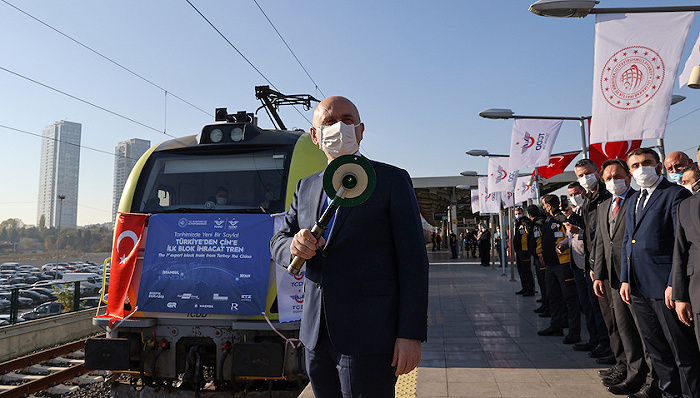On July 26, when meeting with Wang Yi, visiting member of the Central Political Affairs Bureau of the Communist Party of China and director of the Foreign Affairs Office of the Middle Party of the Communist Party of China, Turkish Grand Leader Erdogan expressed his willingness to work closely with China at a high level, strengthen Turkey’s “Middle Corridor” plan and “One Day and One Road” through the mutual Assistance Committee and the Joint Economic and Trade Commission between the authorities of the two countries, and deepen mutual assistance in the areas of commerce, power and tourism. Take the relationship between the soil to a new level.

According to the “Middle East Inspection” news website, Erdogan specifically mentioned that Turkey is looking forward to convening the first meeting of the high-level rest group established for the “Middle Corridor” and “One Day and One Road” to advocate connectivity.
the idea of “the Middle Corridor,” first proposed by Turkey 15 years ago, is considered the centerpiece of the Central Asian strategy of the regional power that towers over Europe and Asia. Through this plan, Turkey may not only establish stronger economic ties with Central Asia, but also improve Turkey’s strategic position by increasing the independence of other Turkic countries against Russia and Iran.
According to the private website of the Turkish Ministry of Communication, “Middle Corridor” is short for “Trans-Caspian Goods Middle Corridor Initiative”. The commercial route, which consists of railways and roads, begins in Turkey, passes through Georgia and Azerbaijan, through the Caucasus region, across the Caspian Sea, and through Central Asia to China.
According to the Ministry, the “Middle Corridor” is the most important component of Turkey’s efforts to revive the ancient Silk Road. In this sense, it creates a natural co-efficacy with the “One Wear one Road” initiative, and Turkey has always supported the connection between the two. In 2015, China and Turkey signed a memorandum of understanding on mutual ties.
Strategically, it bypasses the Northern Corridor (where Russia dominates) and passes through the Indian Ocean via a conservative maritime route (which the United States can block), a commercial route that the Central Asian states have long sought to establish, perhaps linking East Asia with Europe.
To buy its way, Turkey has been pushing for a coherent truce for years. Between 2013 and 2015, Turkey signed agreements with Azerbaijan, China, Georgia and Kazakhstan to improve connectivity between the Middle Corridor and Europe. Turkey is even trying to break up Armenia and Azerbaijan, the “old enemies”, and hopes to repair a new railway through the Armenian Zanguzur region.
Turkey has also been collecting traffic within the perfect country. In 2016, Turkey built the Eurasian Land Tunnel and the Yavuz Sultan Selim Bridge in Istanbul, and is currently implementing the Edirne-Kars high-speed railway and the North Marmati Expressway.
But restoration of the commercial corridor has been slow. Turkey first proposed the idea in 2008, but it was not until 2014, after the opening of the trans-Kazakhstan railway, that the “Middle corridor” took its first step. The next major step is the completion of the Baku-Tbilisi-Kars railway in 2017, the first railway crossing through the Caucasus Mountains since the 1990s.
However, it will not be until 2020 that the first train from Turkey to China will run through the Middle Corridor commercial road. Since then, freight traffic along the corridor has continued to increase, increasing by 52% between 2020 and 2021.
But what really propelled the Middle Corridor to global prominence was last year’s outbreak of conflict between Russia and Ukraine. Although the Central Asian states remain neutral in the conflict, they are more focused on the pursuit of a “northern corridor” to replace Russian dominance as an alternative road for goods moving between Asia and Europe in the face of Western domination over Moscow.
The European Union is also mindful of this path. Since 2022, the growth of the “Middle corridor” has become one of the sticking points in the talks between the EU and Azerbaijan and Central Asian countries, especially Kazakhstan. The 2023 Summer Davos Forum also opened a special “Middle corridor” sub-forum.
European shipping companies have also taken note. For example, Austria’s Rail freight group, Denmark’s Maersk, Finland’s Nurminen Logistics, the Netherlands’ Rail Bridge Cargo and Germany’s CEVA Logistic have all started using “middle corridor” roads.
Commerce along the Middle Corridor seems poised to flourish, but underdevelopment of infrastructure and transshipment services along the route, transit delays and periodic political instability continue to limit the growth of this commercial route.
“The conflict between Russia and Ukraine may have put the growth of the ‘middle corridor’ on track, but there is still a gap between its intended destination.” So wrote Felix K. Chang, a senior fellow at the Communication Strategy Institute (FPRI), a U.S. think tank.
